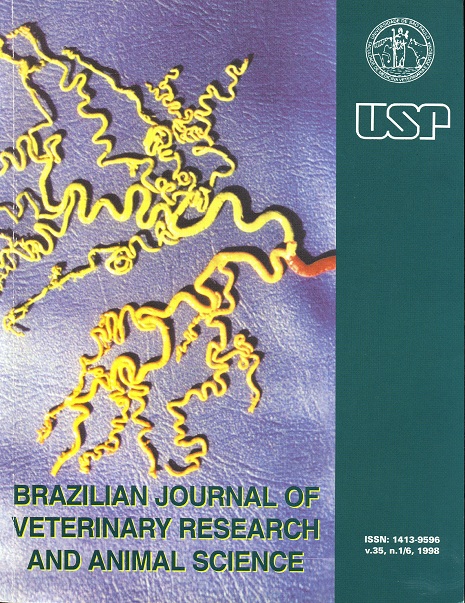Controlled mechanical ventilation in horses under vecuronium blockage
DOI:
https://doi.org/10.1590/S1413-95961998000400008Keywords:
Mechanical ventilation, Vecuronium, General anesthesia, HorsesAbstract
The purpose of this study was to investigate the metabolic and cardiorespiratory effects of the administration of vecuronium under controlled mechanical ventilation versus spontaneous ventilation in horses. Twenty healthy horses scheduled to elective surgery were randomized and assigned in two groups. All animals were pre-medicated with romifidine (100 mu g/kg iv), anesthesia was induced with an association of tiletamine-zolazepam (2 mg/kg iv) and was maintained with halothane. Animals of group I remained in spontaneous ventilation without muscle relaxation while group II received vecuronium (0.1 mg/kg IV) and was submitted to controlled mechanical ventilation. Vecuronium administration did not cause any significant change of heart rate or rhythm, central venous pressure and arterial pressure. With the animals that remained under spontaneous ventilation, no differences were observed in these parameters. The animals that received vecuronium showed lower values of PaCO2 and normal values of pH in relation to the spontaneous ventilation group. Vecuronium duration was 12.83 ± 1.72 minutes. After halothane discontinuation the weaning time in group I I was 6.09 minutes with mean final PaCO2 values of 50.78 mmHg. There was no need of pharmacological reversion of vecuronium effect and recovery from anesthesia was similar in the two groups. In conclusion, the use of mechanical controlled ventilation and vecuronium in horses is easily performed, does not induce further cardiovascular depression and should be employed in equines undergoing major operations.Downloads
Download data is not yet available.
Downloads
Published
1998-01-01
Issue
Section
VETERINARY MEDICINE
License
The journal content is authorized under the Creative Commons BY-NC-SA license (summary of the license: https://
How to Cite
1.
Fantoni DT, Alvarenga J de, Silva LCLC da, Cortopassi SRG, Mirandola RMS. Controlled mechanical ventilation in horses under vecuronium blockage. Braz. J. Vet. Res. Anim. Sci. [Internet]. 1998 Jan. 1 [cited 2024 Nov. 22];35(4):182-7. Available from: https://revistas.usp.br/bjvras/article/view/5699





